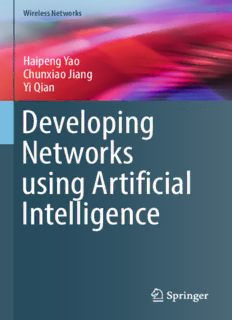Table Of ContentWireless Networks
Haipeng Yao
Chunxiao Jiang
Yi Qian
Developing
Networks
using Artificial
Intelligence
Wireless Networks
Serieseditor
XueminShermanShen
UniversityofWaterloo,Waterloo,ON,Canada
Moreinformationaboutthisseriesathttp://www.springer.com/series/14180
Haipeng Yao • Chunxiao Jiang (cid:129) Yi Qian
Developing Networks using
Artificial Intelligence
123
HaipengYao ChunxiaoJiang
SchofInfo&CommunicationEngg TsinghuaSpaceCenter
BeijingUniversityofPostsandTelecomm TsinghuaUniversity
China,Beijing,China Beijing,Beijing,China
YiQian
DeptofElectrical&ComputerEngg
UniversityofNebraska-Lincoln
Omaha,NE,USA
ISSN2366-1186 ISSN2366-1445 (electronic)
WirelessNetworks
ISBN978-3-030-15027-3 ISBN978-3-030-15028-0 (eBook)
https://doi.org/10.1007/978-3-030-15028-0
LibraryofCongressControlNumber:2019935167
©SpringerNatureSwitzerlandAG2019
Thisworkissubjecttocopyright.AllrightsarereservedbythePublisher,whetherthewholeorpartof
thematerialisconcerned,specificallytherightsoftranslation,reprinting,reuseofillustrations,recitation,
broadcasting,reproductiononmicrofilmsorinanyotherphysicalway,andtransmissionorinformation
storageandretrieval,electronicadaptation,computersoftware,orbysimilarordissimilarmethodology
nowknownorhereafterdeveloped.
Theuseofgeneraldescriptivenames,registerednames,trademarks,servicemarks,etc.inthispublication
doesnotimply,evenintheabsenceofaspecificstatement,thatsuchnamesareexemptfromtherelevant
protectivelawsandregulationsandthereforefreeforgeneraluse.
Thepublisher,theauthorsandtheeditorsaresafetoassumethattheadviceandinformationinthisbook
arebelievedtobetrueandaccurateatthedateofpublication.Neitherthepublishernortheauthorsor
theeditorsgiveawarranty,expressorimplied,withrespecttothematerialcontainedhereinorforany
errorsoromissionsthatmayhavebeenmade.Thepublisherremainsneutralwithregardtojurisdictional
claimsinpublishedmapsandinstitutionalaffiliations.
ThisSpringerimprintispublishedbytheregisteredcompanySpringerNatureSwitzerlandAG.
Theregisteredcompanyaddressis:Gewerbestrasse11,6330Cham,Switzerland
Preface
With the software-defined networking (SDN), network function virtualization
(NFV), and fifth-generation wireless systems (5G) development, the global net-
work is undergoing profound restructuring and transformation. However, with the
improvement of the flexibility and scalability of the networks, the ever-increasing
complexityofnetworksmakeseffectivemonitoring,overallcontrol,andoptimiza-
tion extremely difficult. Recently, adding intelligence to the control plane through
AIandMLbecomesatrendandadirectionofnetworkdevelopment.
In this book, we apply different machine learning approaches to investigate
solutionsforintelligentmonitoring,overallcontrol,andoptimizationofnetworks.
We focus on four scenarios of successfully applying machine learning in network
space.
Intelligent Network Awareness In the network, different applications produce
various traffic types with diverse features and service requirements. Therefore, in
ordertobettermanageandcontrolnetworking,theintelligentawarenessofnetwork
trafficplaysasignificantrole.InChap.3,wediscussthemainchallengeofnetwork
traffic intelligent awareness and introduced several machine learning-based traffic
awareness algorithms, such as traffic classification, anomaly traffic identification,
andtrafficprediction.
IntelligentNetworkControl Findingthenear-optimalcontrolstrategyisthemost
critical and ubiquitous problem in a network. However, the traditional works on
thecontrolplanearelargelyreliedonamanualprocessinconfiguringforwarding,
which cannot be employed for nowadays network condition. To address this
issue, several artificial intelligence approaches for self-learning control strategies
innetworksareintroducedinChap.4.
Intelligent Network Resource Allocation Resource management problems are
ubiquitous in the networking field, such as job scheduling, bitrate adaptation in
video streaming, and virtual machine placement in cloud computing. Compared
with the traditional with-box approach, ML methods are more suitable to solve
v
vi Preface
the complexity of network resource allocation problems. Part of these works is
introducedinChap.5.
Intent-Based Networking Management Future networks need to capture busi-
ness intent and activate it network-wide in order to bridge the gap between
the business needs and the network deliveries. Therefore, in this book, semantic
comprehension function is introduced to the network to understand the high-level
businessintent.PartoftheseworksisintroducedinChap.6.
The topic of AI-driven networking is quite hot in current academia. We can
now find many books on this topic. The following two features make this book a
uniquesourceforstudentsandresearchers.Thisbookpresentsafour-tiernetwork
architecturenamedNetworkAI,whichisapplyingAIandMLtodealwithdifferent
level challenges of today’s networking. This book presents a formalized analysis
of several up-to-date networking challenges like virtual network embedding, QoS
routing, etc. Some machine learning methods were introduced to effectively solve
these challenges. These successful cases show how the ML can benefit and
acceleratethenetworkdevelopment.
Overall,thisbookaimsatgivingacomprehensivediscussiononthemotivation,
problem formulation, and research methodology on applying machine learning in
thefutureintelligentnetwork.Althoughwemadeanearnestendeavorforthisbook,
theremaystillbeerrorsinthebook.Wewouldhighlyappreciateifyoucontactus
whenyoufindany.
Beijing,China HaipengYao
Beijing,China ChunxiaoJiang
Omaha,NE,USA YiQian
Acknowledgments
Thankstoallthecollaboratorswhohavealsocontributedtothisbook:TianleMai,
MengnanLi,ChaoQiu,PeiyingZhang,YaqingJin,andYiqiXue.
vii
Contents
1 Introduction .................................................................. 1
1.1 Background.............................................................. 1
1.2 OverviewofSDNandMachineLearning ............................. 2
1.2.1 SoftwareDefinedNetworking(SDN) ......................... 2
1.2.2 MachineLearning .............................................. 4
1.3 RelatedResearchandDevelopment.................................... 9
1.3.1 3GPPSA2....................................................... 9
1.3.2 ETSIISGENI................................................... 9
1.3.3 ITU-TFG-ML5G............................................... 10
1.4 OrganizationsofThisBook ............................................ 11
1.5 Summary ................................................................ 12
2 Intelligence-DrivenNetworkingArchitecture ............................ 13
2.1 Network AI: An Intelligent Network Architecture for
Self-LearningControlStrategiesinSoftwareDefinedNetworks..... 13
2.1.1 NetworkArchitecture .......................................... 15
2.1.2 NetworkControlLoop ......................................... 17
2.1.3 UseCase ........................................................ 23
2.1.4 ChallengesandDiscussions.................................... 26
2.2 Summary ................................................................ 28
References..................................................................... 28
3 IntelligentNetworkAwareness............................................. 31
3.1 Intrusion Detection System Based on Multi-Level
Semi-SupervisedMachineLearning................................... 31
3.1.1 ProposedScheme(MSML) .................................... 32
3.1.2 Evaluation....................................................... 40
3.2 IntrusionDetectionBasedonHybridMulti-LevelDataMining ..... 50
3.2.1 TheFrameworkofHMLD ..................................... 52
3.2.2 HMLDwithKDDCUP99 ...................................... 55
3.2.3 ExperimentalResultsandDiscussions ........................ 65
ix
x Contents
3.3 AbnormalNetworkTrafficDetectionBasedonBigData
Analysis ................................................................. 69
3.3.1 SystemModel................................................... 70
3.3.2 SimulationResultsandDiscussions ........................... 71
3.4 Summary ................................................................ 80
References..................................................................... 81
4 IntelligentNetworkControl ................................................ 85
4.1 Multi-ControllerOptimizationinSDN ................................ 85
4.1.1 SystemModel................................................... 86
4.1.2 Methodology.................................................... 89
4.1.3 SimulationResults.............................................. 91
4.2 QoS-EnabledLoadSchedulingBasedonReinforcement
Learning................................................................. 94
4.2.1 SystemDescription............................................. 95
4.2.2 SystemModel................................................... 98
4.2.3 ProblemFormulation........................................... 100
4.2.4 SimulationResultsandDiscussions ........................... 105
4.3 WLANInterferenceSelf-OptimizationBasedSOMNeural
Networks ................................................................ 109
4.3.1 SomNetworkTraining ......................................... 110
4.3.2 SomNeuralNetworkOptimization............................ 110
4.3.3 NetworkTrainingAndSimulation............................. 114
4.3.4 PowerEfficiencySimulation .................................. 120
4.4 Blockchain-BasedSoftware-DefinedIndustrialInternetof
Things:ADuelingDeepQ-LearningApproach....................... 127
4.4.1 SystemModel .................................................. 128
4.4.2 NetworkModel ................................................. 128
4.4.3 Blockchain-BasedConsensusProtocol ....................... 131
4.4.4 DetailedStepsandTheoreticalAnalysis ...................... 133
4.4.5 ProblemFormulation .......................................... 136
4.4.6 DuelingDeepQ-Learning...................................... 138
4.4.7 SimulationResultsandDiscussions ........................... 142
4.5 Summary ................................................................ 148
References..................................................................... 150
5 IntelligentNetworkResourceManagement .............................. 157
5.1 VirtualNetworkEmbeddingBasedonRDAM........................ 157
5.1.1 SystemModelandProblemFormulation...................... 158
5.1.2 RDAMAlgorithm .............................................. 162
5.1.3 DynamicUpdateofSubstrateNetwork........................ 165
5.1.4 NetworkModelling............................................. 170
5.1.5 TrainingandTesting............................................ 172
5.1.6 Experiments..................................................... 175
Description:This book mainly discusses the most important issues in artificial intelligence-aided future networks, such as applying different ML approaches to investigate solutions to intelligently monitor, control and optimize networking. The authors focus on four scenarios of successfully applying machine lea

